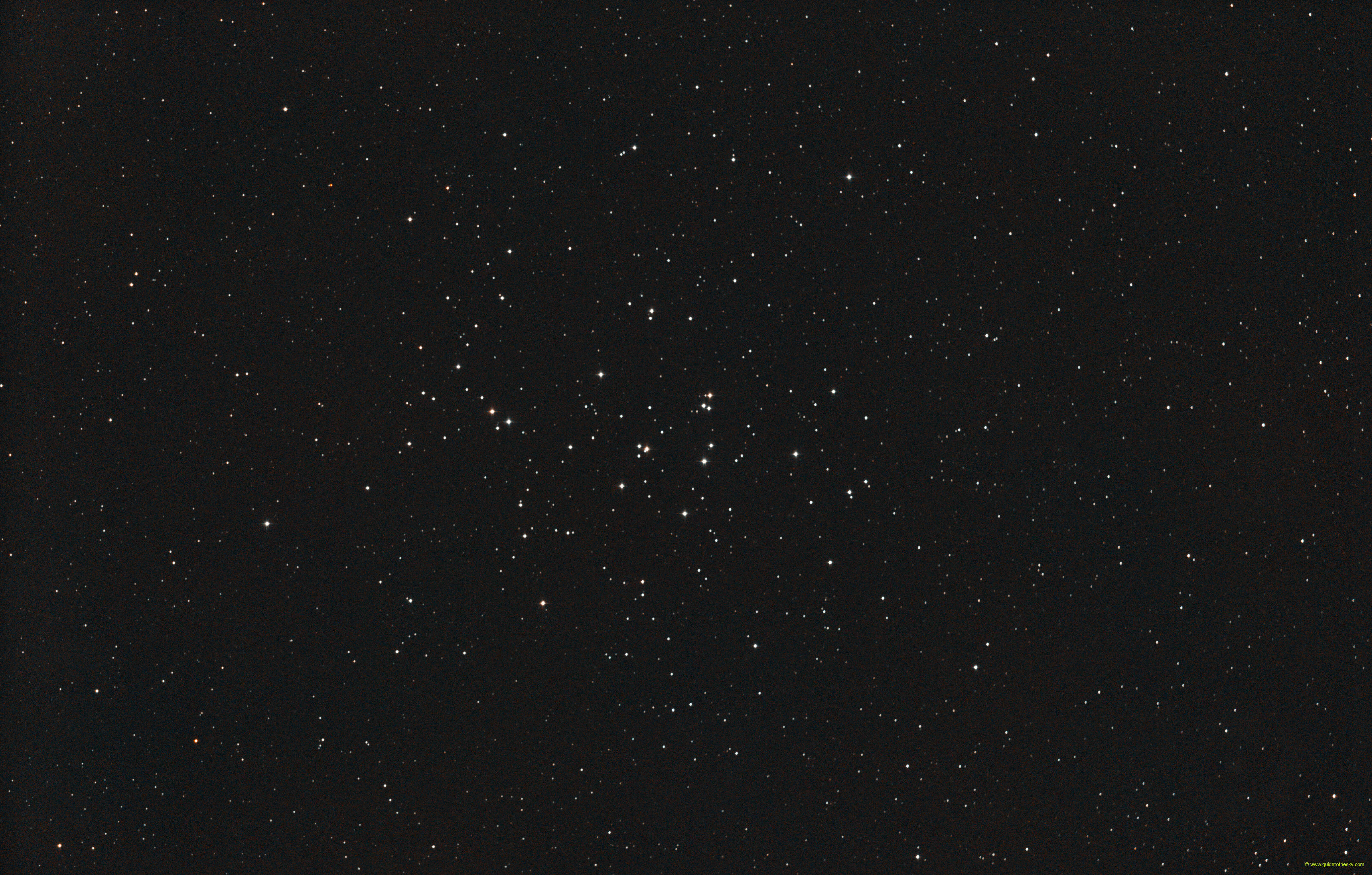Messier 44 - Cancer

M44, o El Pesebre es uno de los cúmulos abiertos más famosos y brillantes del cielo. Compuesto prinicpalmente por unas 20/25 estrellas brillantes, entre la 6ª y 7ª magnitud y luego otro piso de la9ª. En total, unas 100 estrellas componen este aglomerado estelar. Es inconfundible, en este cúmulo una agrupación en forma de pentágono o de cuña apuntando al Norte.
En el Pesebre abunda la agrupación en parejas, y otra carácterística importante de este cúmulo es que está compuesto de estrellas de diferentes colores, a diferencia de Lás Pléyades, donde casi todos sus componentes son azules y aún podemos ver parte de la nebulosa de la que se formó, no vemos esto en M44, lo que nos da una idea de que M44 o El Pesebre es mucho más antíguo que M45 o Las Pléyades.
Por lo demás, M44 es relativamente cercano, dista unos {{object[0].M44.mesDistances[0].dist }} {{ object[0].M44.mesDistances[0].unit }} de nosotros.
M44 - El enjambre, o el Pesebre - en la IA
Messier 44 (M44), also known as the Beehive Cluster or Praesepe (Latin for "manger"), is a prominent open cluster in the constellation Cancer. Here's a breakdown of its key features:
Key Characteristics:
- Type: Open Cluster
- Distance: Approximately 577 light-years (177 parsecs) from Earth
- Age: Estimated to be around 600 million years old, making it relatively old for an open cluster.
- Magnitude: Integrated visual magnitude of 3.7, making it visible to the naked eye under dark, clear skies.
- Size: Spans about 95 light-years across, with a tidal radius of 39.2 light years. In the sky, it appears about 3 times the size of the full Moon.
- Membership: Contains approximately 1,000 stars within its tidal radius.
- Location: Right Ascension (RA): 08h 40m 24s, Declination (Dec): +19° 41′ 00″ (J2000)
- Coordinates (J2000): RA 08h 40.1m, Dec +19° 59'
Why it's interesting:
- Naked-eye visibility: M44 is one of the few open clusters easily visible to the naked eye, making it a favorite target for amateur astronomers.
- Rich field of stars: Even binoculars reveal dozens of sparkling stars, earning it the nickname "Beehive Cluster." Telescopes show hundreds.
- Age and Evolution: Its age provides valuable insights into the evolution of open clusters and the lifecycles of stars.
- Presence of White Dwarfs: M44 contains several white dwarf stars, which are the remnants of stars that have exhausted their nuclear fuel. These remnants provide clues about the cluster's earlier population of more massive stars.
- Planets: There is at least one planet known to orbit a star within M44 (Pr0201 b), a hot Jupiter. The Kepler spacecraft did some work to find more, but the age of the system makes planet-finding difficult.
- Ancient History: M44 was known to ancient astronomers, including Hipparchus and Ptolemy. It was considered a nebulous object before telescopes could resolve its individual stars.
Observing M44:
- When to Observe: Best viewed during the winter and spring months when Cancer is high in the night sky.
- How to Find It: Locate the constellation Cancer, which is relatively faint. M44 is situated roughly between the bright stars Regulus (in Leo) and Pollux (in Gemini).
- What to Use: Naked eye, binoculars, or a small telescope. Binoculars provide a good balance between field of view and resolution. A small telescope will reveal fainter stars and more detail.
In Summary:
Messier 44 is a beautiful and scientifically important open cluster. Its brightness, large angular size, and rich population of stars make it a rewarding object to observe for astronomers of all levels. Its age also makes it a valuable resource for studying stellar evolution and planetary systems in older open clusters.
Más información sobre Messier 44 en NASA/IPAC.
Mapa alrededor de Messier 44
Otros identificadores de M44:
"[KC2019] Theia 1184" ,"C 0837+201" ,"M 44" ,"NAME Beehive" ,"NAME Praesepe" ,"NGC 2632" ,"OCl 507.0" ,"[KPR2004b] 201" ,"Cl Melotte 88" ,"[KPS2012] MWSC 1527" ,"NAME Praesepe Cluster",

